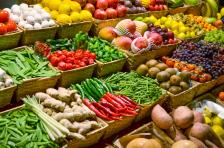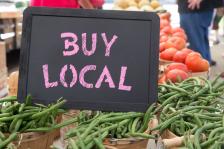10 Tips to Save Money Shopping at Farmers’ Markets
Money Girl gives 10 tips to save money by spending less at your local farmers’ market.
Farmers’ markets are some of the best places to buy high quality food at the lowest prices. But it’s still possible to overspend there, if you’re not careful.
In this episode you’ll learn 10 tips to save money by spending less at your local farmers’ market.
Sponsor: Want to save more, invest for the future, but don’t have time to be a full-on investor? Betterment.com helps you build a customized, low-cost portfolio that suits your goals. Sign up at betterment moneygirl and receive a $25 bonus when you make a deposit of $250 or more.
Click here to subscribe to the weekly Money Girl audio podcast—it’s FREE!
What Is a Farmers’ Market?
A farmers’ market is where a farmer or a produce broker sells fresh goods directly to consumers.
The best markets have a variety of in-season fruits and vegetables—plus other foods like meat, seafood, eggs, cheese, honey, and baked goods. They might also have other vendors, such as food trucks, jewelry makers, musicians, flower stands, and sellers of homemade candles or soap.
Shopping at farmers’ markets can be a fun way to buy healthy food, spend time outdoors, and even meet up with friends.
Here are 10 tips to save money and make sure you get the most out of your local farmers’ market:
Savings Tip #1: Research Nearby Markets
Search online for the best farmers’ markets in your area. Even small towns may have many options, but some may only run from early spring to late fall or be open just one or 2 days a week.
Check out localharvest.org and the United States Department of Agriculture (USDA) directory at usda.org to find the best farmers’ markets near you. Then visit several to see which ones have the best goods and prices.
Savings Tip #2: Bring a Set Amount of Cash
Prices for the same goods can vary from stand to stand. So don’t buy the first gleaming peppers or luscious berries you see.
Most vendors at farmers’ markets don’t accept credit cards, so you generally need to bring cash. While this might seem like an inconvenience, think of it as an easy way to make sure you don’t overspend.
Decide ahead of time how much you should spend and only bring that much cash to the market. Once you’ve spent your cash limit, well, then it’s time to head home and start cooking.
Savings Tip #3: Plan Ahead
As I mentioned, many farmers’ markets have a lot of terrific items for sale that you may be tempted to buy. While it’s always fun to wander around and see what a market has to offer, don’t come home with stuff you really don’t need.
See also: The Case for Meal Planning
To avoid unnecessary purchases, have a shopping plan. Go to the market with a list of ingredients you need to prepare the next 3 to 5 meals. Also, bring shopping bags and perhaps a cooler with ice if you need seafood, meats, or cheeses.
Savings Tip #4: Walk the Market Before Buying
Prices for the same goods can vary from stand to stand. So don’t buy the first gleaming peppers or luscious berries you see.
Instead, walk through the entire market and check out all the vendors selling the items on your list. Take note of the prices and quality and then go back to make your purchases after you’ve seen what is available.
Savings Tip #5: Know What’s In-Season
In-season fruits and vegetables will cost less and probably taste better than those shipped from distant places out of season.
See also: Are Organic Foods Worth the Cost?
Use the Natural Resources Defense Council’s Eat Local Map or the Seasonal Ingredient Map at epicurious.com to find out what’s in season by state, month, and food.
Savings Tip #6: Know Prices

Some produce may actually be less expensive at a conventional grocery store. However, choosing the least expensive food isn’t always best, since the quality may be poor. Or, you may prefer to support local farms regardless of price, if you can afford it.
Savings Tip #7: Don’t Buy Too Much
While this might seem like an obvious tip, don’t overestimate how much you can eat or how long produce from the farmers’ market will last. Wasted food equals wasted money. Think about how many ears of corn or stalks of asparagus you can eat within the next week and err on the side of buying less rather than more.
Or, if you like buying in bulk you can certainly get additional savings. Most fruits and vegetables can be frozen for up to several months, as long as you prepare them properly and have room in the freezer. Check out Domestic CEO’s tips on how to freeze 60 pounds of vegetables and 40 pounds of chicken without wasting a thing.
Savings Tip #8: Shop with a Money-Savvy Friend
If you want to keep yourself in check, consider shopping with a friend or family member. Not only can they help you stick to your spending plan, but they may be interested in sharing bulk purchases with you.
Savings Tip #9: Become a Market Volunteer

Volunteers may be rewarded with free or discounted produce or have the pick of items in oversupply.
Savings Tip #10: Shop Right Before Closing
Although a stand’s selection might be picked-over right before a farmers’ market closes, many vendors would rather discount what’s left than have to take it home. Plus, the produce could be starting to ripen quickly or wilt.
Not all markets allow last-minute discounting, but it’s worth watching for. It’s in a vendor’s best interest to make sales and not end up with rotten produce.
If you have other tips for saving money at farmers markets be sure to share them on the Money Girl Facebook page.
Get More Money Girl!
For exclusive money tips not covered on the Money Girl podcast, click here and sign up for the free Money Girl Newsletter!
To connect on social media, you’ll find Money Girl on Facebook, Twitter, and Google+. Also, if you’re not already subscribed to the Money Girl podcast on iTunes, that’s how most people get the show. Subscribing is always free and makes sure that you’ll get each new weekly episode as soon as it’s published on the web.
There’s a huge archive of past articles and podcasts if you type in what you want to learn about in the search bar at the top of the page. Here are all the many places you can connect with me, learn more about personal finance, and ask your money question:
- Google+
- Money Girl podcast on iTunes (it’s free to subscribe!)
- Email: money@quickanddirtytips.comcreate new email“>money@quickanddirtytips.comcreate new email
- Click here to sign up for the free Money Girl Newsletter!
 Download FREE chapters of Money Girl’s Smart Moves to Grow Rich
Download FREE chapters of Money Girl’s Smart Moves to Grow Rich
To learn about how to get out of debt, save money, and build wealth, get a copy of my book Money Girl’s Smart Moves to Grow Rich. It tells you what you need to know about money without bogging you down with what you don’t. It’s available at your favorite book store in print or as an e-book for your Kindle, Nook, iPad, PC, Mac, or smart phone. You can even download 2 free book chapters at SmartMovesToGrowRich.com!
Man at farmers’ market and buy localimages courtesy of Shutterstock.



 Download FREE chapters of Money Girl’s Smart Moves to Grow Rich
Download FREE chapters of Money Girl’s Smart Moves to Grow Rich



